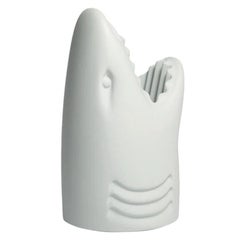Killer White Shark Umbrella Stand
Recent Sales
2010s Italian Modern Umbrella Stands
Plastic
A Close Look at modern Furniture
The late 19th and early 20th centuries saw sweeping social change and major scientific advances — both of which contributed to a new aesthetic: modernism. Rejecting the rigidity of Victorian artistic conventions, modernists sought a new means of expression. References to the natural world and ornate classical embellishments gave way to the sleek simplicity of the Machine Age. Architect Philip Johnson characterized the hallmarks of modernism as “machine-like simplicity, smoothness or surface [and] avoidance of ornament.”
Early practitioners of modernist design include the De Stijl (“The Style”) group, founded in the Netherlands in 1917, and the Bauhaus School, founded two years later in Germany.
Followers of both groups produced sleek, spare designs — many of which became icons of daily life in the 20th century. The modernists rejected both natural and historical references and relied primarily on industrial materials such as metal, glass, plywood, and, later, plastics. While Bauhaus principals Marcel Breuer and Ludwig Mies van der Rohe created furniture from mass-produced, chrome-plated steel, American visionaries like Charles and Ray Eames worked in materials as novel as molded plywood and fiberglass. Today, Breuer’s Wassily chair, Mies van der Rohe’s Barcelona chair — crafted with his romantic partner, designer Lilly Reich — and the Eames lounge chair are emblems of progressive design and vintage originals are prized cornerstones of collections.
It’s difficult to overstate the influence that modernism continues to wield over designers and architects — and equally difficult to overstate how revolutionary it was when it first appeared a century ago. But because modernist furniture designs are so simple, they can blend in seamlessly with just about any type of décor. Don’t overlook them.
Materials: plastic Furniture
Arguably the world’s most ubiquitous man-made material, plastic has impacted nearly every industry. In contemporary spaces, new and vintage plastic furniture is quite popular and its use pairs well with a range of design styles.
From the Italian lighting artisans at Fontana Arte to venturesome Scandinavian modernists such as Verner Panton, who created groundbreaking interiors as much as he did seating — see his revolutionary Panton chair — to contemporary multidisciplinary artists like Faye Toogood, furniture designers have been pushing the boundaries of plastic forever.
When The Graduate's Mr. McGuire proclaimed, “There’s a great future in plastics,” it was more than a laugh line. The iconic quote is an allusion both to society’s reliance on and its love affair with plastic. Before the material became an integral part of our lives — used in everything from clothing to storage to beauty and beyond — people relied on earthly elements for manufacturing, a process as time-consuming as it was costly.
Soon after American inventor John Wesley Hyatt created celluloid, which could mimic luxury products like tortoiseshell and ivory, production hit fever pitch, and the floodgates opened for others to explore plastic’s full potential. The material altered the history of design — mid-century modern legends Charles and Ray Eames, Joe Colombo and Eero Saarinen regularly experimented with plastics in the development of tables and chairs, and today plastic furnishings and decorative objects are seen as often indoors as they are outside.
Find vintage plastic lounge chairs, outdoor furniture, lighting and more on 1stDibs.
Finding the Right decorative-baskets for You
Antique and vintage decorative baskets can lend unique charm to any room. And basketmaking is hardly a lost art.
Evidence of basket weaving dates back tens of thousands of years, with one of the most intact examples found in the Judean Desert from the Neolithic period. Historically, baskets have mainly served utilitarian needs — to carry food, store materials and even hold water — but they could also be ornamental objects or have ceremonial or religious purposes.
Native American baskets come from a tradition steeped in generations of skill. There are new and made-to-order baskets from artisans who put their own spin on the ancient art as well as 21st-century pre-owned decorative baskets to complement any furniture style or design preference.
A metal basket or brass basket can match a modern or industrial-style home and add some contrasting rusticity. Wooden baskets, wicker baskets and natural-fiber baskets can easily harmonize with boho chic and cottagecore interiors.
Ceramic baskets are part of the pottery tradition, a craft with a deep heritage in human history. Ceramics are popular in decor again, and the personalization of handmade craftsmanship has served as a sort of anti-Internet to screen-weary decorators. Depending on a ceramic basket’s style, it can fit in with a more formal, cottage, Asian or Southwestern interior theme.
Browse 1stDibs for a wide selection of decorative baskets to fit any design need.
